The Dell Venue 11 Pro 7000 Review
by Brett Howse on April 16, 2015 8:00 AM EST- Posted in
- Tablets
- Dell
- Windows 8.1
- Core M

Back in November, Dell took the lid off of their Venue 11 Pro 7000 refresh which is their first tablet offering to have Core M powering it. Dell is aiming this tablet squarely at the enterprise segment, but with prices that start low enough for consumers to take a look as well. Starting at $699, it is not an inexpensive device, but it does offer some compelling features on top of the powerful (for a tablet) processor. Dell has an entire range of accessories for the tablet to let the end user get the maximum out of the device, and allows the device to be used as a tablet, a laptop, or even a desktop computer.
Dell has leveraged the Intel Core M processor to power this tablet, which gives it quite a bit of a performance boost over most tablets. There are two offerings as well, with the Core M-5Y10c being the base model, and the Core M-5Y71 being the upgrade. Those who opt for the 5Y71 will enjoy the benefits of Intel vPro as well as the peak performance boost of the faster clock speeds of that model.
| Dell Venue Pro 11 7140 Specifications | |
| Processor | Intel Core M-5Y10c (Dual-core + HT 0.8-2.0GHz 4MB L3 14nm 4.5W TDP) Intel Core M-5Y71 (Model Tested) (Dual-core + HT 1.2-2.9GHz 4MB L3 14nm 4.5W TDP) |
| Memory | 4 or 8 GB (model tested) LPDDR3-1600 |
| Graphics | Intel HD 5300 (24 EUs at 100-800MHz on 5Y10c) (24 EUs at 300-900MHz on 5Y71) |
| Display | 10.8" IPS 16:9 FHD (1920x1080) (Samsung SDC4C48 8-bit Panel) 10-point Multitouch |
| Storage | 64GB / 128GB (model tested) / 256GB SSD (Sandisk X110 M.2 2280) |
| Networking | Intel Dual Band Wireless-AC 7265 plus Bluetooth 4.0 (2x2:2 802.11ac 867Mbps capable) Optional LTE |
| Cameras | 2 MP Front Webcam 8 MP Rear Camera |
| Battery/Power | 38 Wh non-removable 24 W Max AC Adapter |
| Ports and I/O | Headset Jack MicroSD Card Reader 1 x USB 3.0 1 x micro HDMI NFC Optional Sensor Hub (Gyro, G-Sensor, Proximity) |
| Operating System | Windows 8.1 64-bit or Pro |
| Dimensions | 11.01" x 6.95" x 0.42" (WxDxH) (279.8mm x 176.4mm x 10.75mm) |
| Weight | 1.59 lbs (722.6g) Wi-Fi 1.65 lbs (747.7g) LTE |
| Pricing | $699 (5Y10, 4GB, 64GB) $749 (5Y10, 4GB, 128GB) $829 (5Y71, 4GB, 128GB) Contact Dell for other options |
The Venue 11 Pro 7000 (henceforth called Venue 11 Pro) is truly an Ultrabook in a tablet form factor, with 4 to 8 GB of memory on tap, 64 to 256 GB of solid state storage, and Windows 8.1 64-bit powering the system. Dell has an optional 4G LTE modem as well, which is something that still seems to be a rare feature on these types of systems.
Accessories
While the Venue 11 Pro is a reasonable tablet on its own merits, what really makes this device is the accessories. Dell has practically everything covered too. If you need a keyboard and extended battery life, they have that. If you want a thin keyboard only, they have that too. A stylus? Check. Docking station? Of course. How about just a case that can be used as a stand? Yes.
Dell Tablet Folio
The folio includes a polycarbonate rear shell which keeps access available to the tablets ports. The front cover will fold behind and double as a stand. Dell sells this case for $24.99.
Dell Venue Keyboard - Slim
This slim keyboard is very much like the Microsoft Surface keyboard covers. Very thin, and yet they feature a keyboard and trackpad. Dell did not send this accessory with the review unit, so I can’t comment on the key feel, but they do claim it has a tactile response. It also features an integrated tablet stand, which of course would be required since this tablet has no way of holding itself up. At just 3.6 mm thick, it is very much similar to the Surface Touch cover in thickness, and it will add 313 grams to the total tablet weight.
The magnetically attached cover is going to come with the same drawbacks of the Microsoft Surface line of attachable keyboards. Although it is thin and light, it really works best on a desk rather than in a lap. While it can be used in a lap in a pinch, it is not ideal. The Slim keyboard is priced at $89.99.
Dell Venue Keyboard – Mobile
For those that want to use the tablet as a convertible laptop, the Mobile keyboard is likely your best bet. The tablet locks into the hinge of this keyboard, and with that proper connection it can be used just like a laptop – albeit a small laptop. The 10.8 inch display means that the accessory is much smaller than a traditional laptop keyboard would be. While the keyboard itself is sized pretty well, it is really the trackpad that suffers, since it is very small.
Dell offers one great feature with this keyboard though. It includes an additional battery, which bumps the tablet’s battery capacity to around 60 Wh total. That is a huge amount of battery for a low powered device, and can really extend the usable lifespan of the tablet which we will see later in the review.
All is not perfect with this keyboard though. First, the price is a very high $179.99. The keyboard and battery costs almost as much as the HP Stream 11 laptop. If it was a premium accessory, perhaps the price could be justified, but there are some major gripes I have with the keyboard. The keys themselves are very mushy and not a great typing experience. Also, there is no backlighting offered, which limits the usability in many scenarios. The trackpad was also not very good. Besides the limited surface area for it, it would often miss taps and it was frustrating to use. The hinge also lifts the rear of the laptop up, and while Dell’s solution is much better than the ASUS Zenbook which does the same thing, ergonomically this benefits no one. Finally, the mobile keyboard adds a lot of thickness and mass to the overall tablet package, with the keyboard coming in at 8.9 mm thick, and a staggering 794 grams. It actually weighs even more than the tablet on its own, over doubling the effective weight.
The keyboard can be charged separate from the tablet, but the power connector has to be plugged into the tablet if both are connected together. It would have been nice for Dell to put the keyboard charging port on the side of the keyboard to allow the power connector to hook up there instead of the side of the tablet when it is being used as a laptop. I do not really have a lot of good things to say about this accessory other than it does do a good job of increasing battery life.
Dell Active Stylus
Dell’s Active Stylus is a Synaptics unit. There have been several revisions of the pen, and the previous Venue 11 Pro also supported an active stylus. Dell has a new model available now, and the new pen works very well. It is smooth to use on the display, and there was never any moments where connectivity would be lost. I am not a stylus expert like some people (ie Gabe at the Penny Arcade) but I had no issues using this model of stylus. The only slight issue was using the pen at the very edges of the display, where the pointer would sometimes jump right to the edge.
Dell Tablet Dock
Unlike the mobile keyboard, the tablet dock is very well constructed. The frame is made out of a piece of stamped steel which is painted black, so it is plenty sturdy. The mass of it also makes it feel well constructed, and the entire bottom is covered in rubber to keep it from moving around on the desk.
Once docked, the tablet basically transforms into a full desktop. There are two USB 3.0 ports on the rear of the dock, and another on the front. The dock includes 10/100 Ethernet, HDMI, DisplayPort, and has a front headphone jack. The dock also includes a 65 watt power adapter, which should easily power the system and any USB accessories. The best part of this dock is the relatively low price at just $79.99.


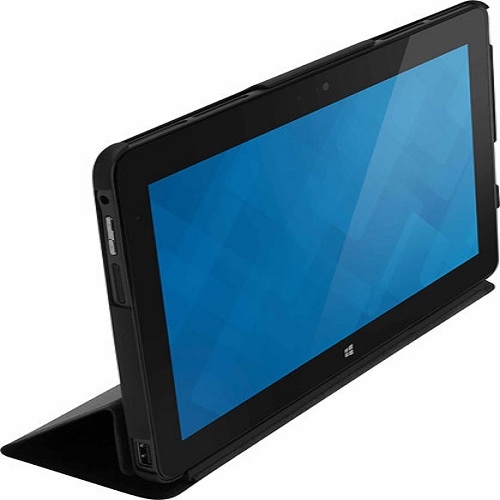
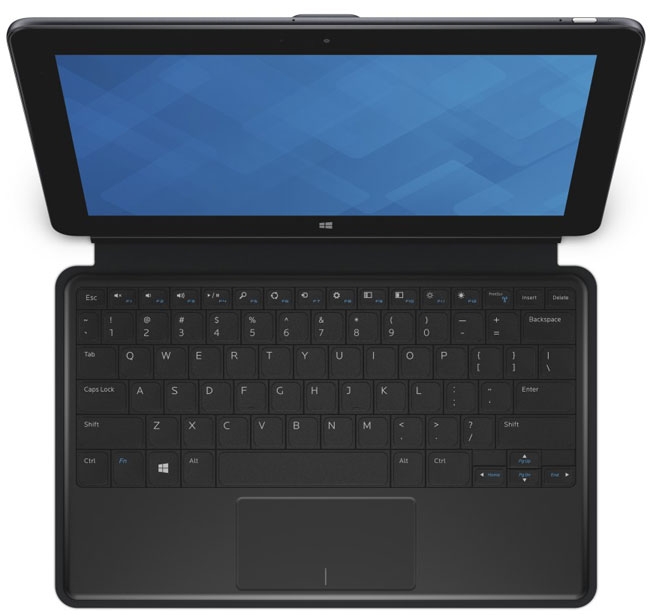
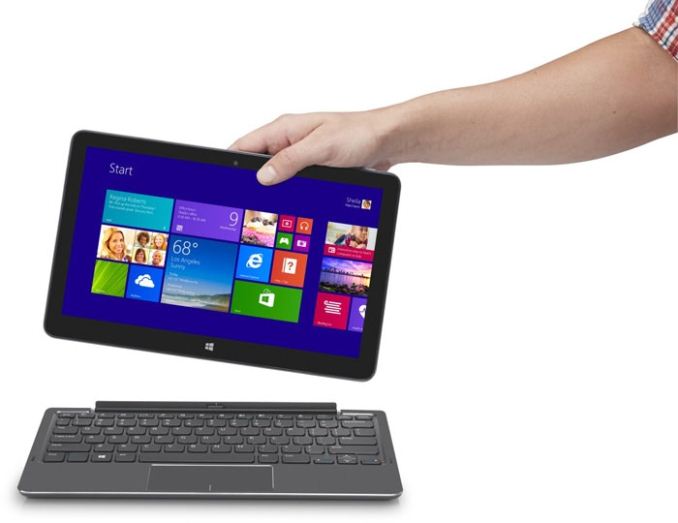
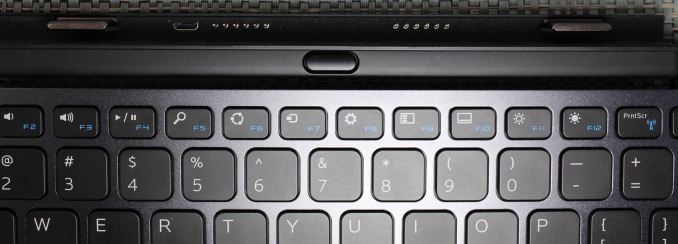

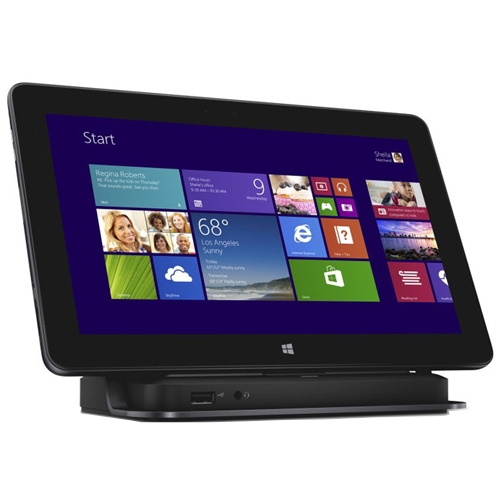








92 Comments
View All Comments
duriel - Thursday, April 16, 2015 - link
The GPU comparison looks a bit strange, since Core M does quite a bit better at 3DMark than at GfxBench. Both Manhattan and IceStorm run for a couple of minutes, so I don't buy the argument that GfxBench is slower because it runs longer (although that might be true for actual games like Dota). Perhaps it is a driver / application optimization issue. I wonder if GfxBench uses OpenGL or DirectX on Windows. Intel is generally known to have better DX drivers than OGL. Too bad we don't have more cross platform graphics benchmarks.lilmoe - Thursday, April 16, 2015 - link
I've seen other reviews around too, and I don't base my judgements on benchmarks alone. It really seams that the GPU is not up to task. How much could they mess up the driver? This isn't Intel's first attempt at iGPUs...thunng8 - Friday, April 17, 2015 - link
Ice Storm is a fair bit shorter than gfxBench benchmarks and IMO gfxBench graphically looks much better especially ManhattanShadowmaster625 - Thursday, April 16, 2015 - link
I hope they keep pushing these thigns out. When we go into the next recession these things will be all over slickdeals for $400 maybe even $300. At around $400 this is a very compelling product.chizow - Thursday, April 16, 2015 - link
I was part of the validation process for these Venue Pros and other tablet/2-in-1s for work and we decided not to use these in favor of the Surface Pro 3 mixed in with some Yoga Pros and Transformer T300s (for users who wanted more of a 2-in-1 experience).There were a number of major problems with the Venue Pro that we ran into compared to the competitors and really only one positive.
Pros: Take care of this easy one first, it has a built-in SC Reader. It works poorly, but it is there. This is an important feature for any Enterprise that does business with the Government or has the highest security standards.
Cons:
-1080p 16:9 aspect ratio is terrible for tablet portrait usage. Works OK on a smartphone because that's all we've ever known, but for web content and even most documents, 16:9 just doesn't work and often forces you to scroll LR on a page, especially if there is a menu/banner on either side.
-Heavy and thick. Just feels really heavy. Maybe its due to the stocky dimensions, but it just feels heavy in the hand and it is considerably thicker than the SP3. It feels even worst as a tablet than the original Surface Pro and Pro 2.
-Dock. Price and overall build quality on the dock is good, but attaching it is not as easy as the SP3 dock and you also can't attach the keyboard while docked like you can with the SP3's dock. Also not as many connectivity options but overall the dock is good especially for the price.
-Folio Keyboard. This thing is awful, can't even be compared to the SP3's dock and it is also unnecessarily thick due to the multiple manifolds required for its stand-up folio action. The keyboard itself feels awful, almost no key travel it is more like the touchpads that also double as buttons for your entire keyboard. Also, in "laptop" mode it just doesn't work well because the tablet is SO much heavier than the keyboard and the only support you have is the flexible folio back kickstand. If you want a 2-in-1 spring for the new rigid typepad/battery accessory or look at the Asus Transformer T300 or Yoga Pro 3.
-Probably no longer an issue with this Core M variant, but the i5 unit I had the fan would ramp up and it would get LOUD.
So yeah, would definitely check this one out in person before you buy, from my testing and time spent validating multiple of these options, I would spend a bit more and go with a Surface Pro 3 i5 variant with 4GB/128GB or 8GB/256GB or one of the higher-end Surface 3 (non-Pro). Surface Pro line is probably due for an update soon anyways, I would expect to see a Core M variant replacing the low-end i3.
Brett Howse - Thursday, April 16, 2015 - link
So just to clarify, your experience is with the older model then? Obviously this one is quiet since it is passively cooled. It's great to hear from people who have a lot of experience with these devices.chizow - Friday, April 17, 2015 - link
Yeah it was the older i5 model but I figured Core M would quiet it down which is great to hear. I did also go back and read the parts of the review on the dimensions and it does look like they addressed the thickness and weight concerns somewhat, but I am not sure they've done enough to address the 2-in-1 and screen size/aspect ratio concerns.In any case I do laud Dell for taking a chance on this segment but like the Surface Pro line, I think more iterations and improvements are needed for this product to do well.
DigitalFreak - Thursday, April 16, 2015 - link
We bought a bunch of these @ work. Absolute junk. Do yourself a favor and look at the Lenovo Helix.lilmoe - Thursday, April 16, 2015 - link
Mind sharing your experience? Was it performance or overall quality?Azurael - Thursday, April 16, 2015 - link
Was that the previous 7130 model? They launched with a shedload of issues after receiving numerous positive reviews. The screen would freeze frequently unless panel self refresh was disabled, the touch screens would register double taps constantly, the stylus was basically useless and the SSDs got laggy over time. After several BIOS updates and firmware updates for almost every component I could imagine having updateable firmware (and not just the touch controller, but the LCD panel itself) it works great. I think Dell really dropped the ball, I assume businesses had already given up on them by that point which is good for me, because refurbs are numerous and cheap :)